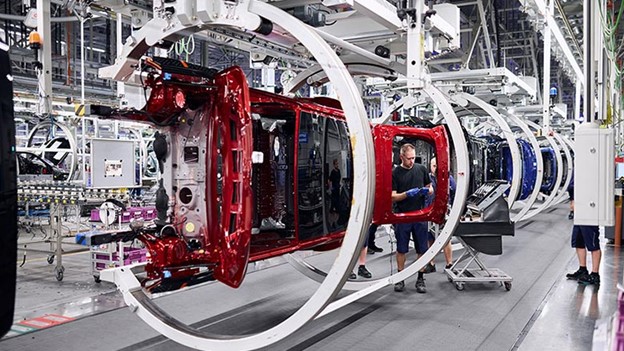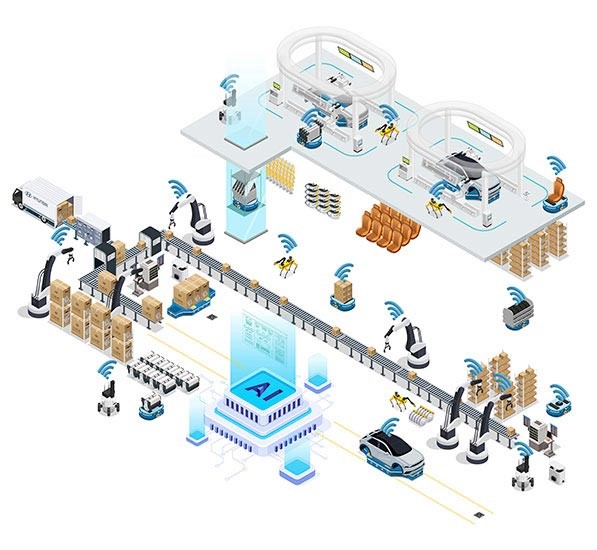Assembly Magazine: The Growing Role of AI in Automotive Assembly
The Growing Role of AI in Automotive Assembly
By Austin Weber
Article excerpt from Assembly Magazine

A state-of-the-art AI system monitors assembly line conveyors at BMW’s factory in Regensburg, Germany. Photo courtesy BMW AG
January 30, 2024
Artificial intelligence (AI) is the hottest trend to hit automotive assembly lines since lean manufacturing in the 1990s. Automakers and suppliers around the world are scrambling to adopt AI technology to boost efficiency, improve quality and reduce errors in their factories.
Automotive AI applications include next-generation vision systems for adhesive dispensing, screwdriving and welding applications, plus parts inspection, plant layout and predictive maintenance. The technology is also making conveyors, robots, vision systems and other production tools more intelligent.

Artificial intelligence is making conveyors, robots, vision systems and other production tools more intelligent. Illustration courtesy Hyundai Motor Group
“Improving the quality of vehicles and simultaneously improving margins have always been the goals for automotive OEMs,” says Ravi Kunju, chief product and strategy officer at software firm Altair Engineering Inc. “Every technology in use today is working toward achieving just this.
“AI helps accelerate these efforts from design to manufacturing in a continuous loop that we define as ‘One Total Twin,’” explains Kunju. “This leverages synthetic data from computational sciences and raw data from the factory floor, converging them with data sciences, such as AI and machine learning, to create a unique value.
“The implications from digital twin technology are substantial at every stage of vehicle design and manufacturing,” notes Kunju. “While [this] is not new and has been in use for some time, the advent of ChatGPT has made AI a popular topic.
“The biggest benefit of using AI in car manufacturing is that businesses are asking themselves what they can learn from the entire digital data infrastructure within their organization,” Kunju points out. “The implications are massive.”
Quality Control
According to Kunju, AI is having a dramatic impact on automotive manufacturing when it comes to quality control and predictive maintenance applications.
“A variety of conditions can affect manufacturing, resulting in variability and inconsistencies,” says Kunju. “AI is increasingly used to predict the right process parameters based on data for what has historically worked or failed.
“Less than 10 percent of factory data from machines is utilized today,” claims Kunju. “Analyzing this data unlocks potential for improvements in process across multiple manufacturing processes.
“Many tasks that are extremely manual , difficult to scale or labor intensive, such as visual inspection of assembly gaps and weld quality, are being trained using photo sensors in combination with advanced machine learning and AI,” explains Kunju. “This can be extended to any other quality criteria, as long as they can be easily scored from a qualitative to a quantitative measure, which requires good understanding of the domain of interest.”
AI has allowed for the use of many more sensors on assembly lines and paved the way for increased data acquisition. The next phase of adopting AI will be to streamline the data and use human intelligence to convert the qualitative data into quantitative metrics that attempt to measure outcomes, achieve reinforced learning and automate production equipment to recorrect on the fly.
“All of this requires a tectonic shift in data-driven decision making and intentional organizational transformation,” warns Kunju. “Some manufacturers will emerge as leaders, taking advantage of AI quickly, while others will need to play catch up.”
“The automotive industry has witnessed a remarkable transformation with the integration of artificial intelligence,” adds Iu Ayala, CEO of Gradient Insight Ltd., an AI consulting firm that specializes in computer vision technology. “One of the most significant trends is the application of computer vision in quality control processes along assembly lines.
“Computer vision algorithms, honed through years of research and development, are now adept at identifying even the minutest defects in car components, ensuring a level of precision that was previously unattainable,” says Ayala.
“Take, for instance, our recent collaboration with a leading automaker,” explains Ayala. “We implemented a computer vision system that analyzes paint quality on car bodies.
“Through advanced image recognition techniques, the system can detect imperfections such as uneven coatings or color discrepancies,” claims Ayala. “This not only ensures a flawless finish, but also significantly reduces the likelihood of defects reaching the end consumer, thereby enhancing overall product quality.
“Another notable trend is the utilization of AI-powered predictive maintenance,” says Ayala. “In a dynamic production environment, unexpected machinery breakdowns can lead to costly downtime.
“By leveraging machine learning algorithms, we’ve assisted car manufacturers in predicting equipment failures before they occur,” notes Ayala. “This proactive approach enables scheduled maintenance, preventing disruptions and optimizing the efficiency of the assembly line.”
Numerous Products
Automotive engineers can choose from a wide variety of AI-enhanced products, including the following:
Coherix Inc. recently developed an inspection system that uses artificial intelligence and machine vision technology to ensure that the correct amount of adhesive is applied during the battery assembly process. The company has also created software capable of automatically adjusting the application of adhesives at line speed to improve quality, cut downtime, and reduce labor and material costs.
Last year, Hexagon’s Manufacturing Intelligence division launched an automated robotic inspection cell called PRESTO that enables manufacturers to reduce quality inspection times, increase efficiency and streamline workflows. It enables end-to-end inspection in a turnkey package and is powered by 3D-laser scanning. That ensures that any surface, even highly reflective materials, can be easily inspected…
Continue reading in Assembly magazine